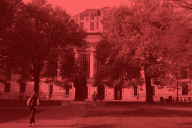You have /5 articles left.
Sign up for a free account or log in.
A proposal that would end the use of race and gender as a consideration in government hiring and public college admissions in Michigan will appear on the ballot in November 2006, following a ruling Monday by the Michigan Court of Appeals.
The court ruled that a petition supporting the proposed amendment to the state constitution by the Michigan Civil Rights Initiative is valid, and has enough signatures to get on the ballot.
A 2003 poll conducted by EPIC-MRA, a public opinion research firm, showed that about 60 percent of likely Michigan voters oppose the use of race in college admissions. Experts agreed that having the proposal on the ballot will probably bring affirmative action -- which was allowed by the U.S. Supreme Court in a ruling for the University of Michigan in 2003 -- to an end in Michigan.
The court ruling plucked the petition out of limbo. By January of this year, the sponsors had used thousands of solicitors, both volunteers and workers paid at least $1 per signature, to get over 500,000 signatures. In the following months, however, the state Board of Canvassers listened to complaints from pro-affirmative action groups that the petition should be invalidated. The groups presented affidavits and letters from people who said they were deceived by the petition solicitors.
In one account, Ruthie Stevenson, president of the Macomb County NAACP, describes being approached by a solicitor who told her, “the president of the Macomb County NAACP is in support of this.” Stevenson testified that she responded by telling the solicitor “I am Ruthie Stevenson” and that “I am not in support of this … anti-civil rights initiative.”
A letter from Robert Ziolkowski, a Michigan circuit court judge, details how he was approached while shopping and signed the petition that he said was represented to him as pro-affirmative action. Then, “having glanced at the title, and lengthy caption language, I signed the petition,” he wrote. When Ziolkowski went back to read the petition over, he struck his signature out, and asked the solicitor why she had misrepresented the petition. “She said that was what she was told to say,” Ziolkowski wrote. Letters from a few of the circulators claim that they did not know what the petition was, and just told people it was pro-affirmative action.
The concerns led the board to a split decision over whether to launch an investigation of the petition, which the Secretary of State’s Office, based on a random sample, had already found to have over 450,000 valid signatures, well above the required 317,000.
Without board certification, the proposal was stuck. The ruling by the Court of Appeals, however, said that the Board of Canvassers was outside its reach in considering an investigation, and can only certify or negate a petition. With that, the court ordered the board to certify the petition based on the fact that it has enough signatures, and was found to have an appropriate format.
Lawyers for the pro-affirmative action groups will file a motion for the court to reconsider, and will appeal to the state Supreme Court if that fails. “It’s outrageous that the court is saying [the board] doesn’t have a right to investigate,” said Shanta Driver, one of the lawyers on the case, and national co-chair of a group, known as By Any Means Necessary, that is organizing opposition to the initiative. “The board is the only body that can do that. It is the last gatekeeper for petitions.”
Carl Cohen, a philosophy professor at the University of Michigan and an outspoken critic of affirmative action, said that he does not believe there was deliberate misrepresentation, and that the proposal was on the petition for signers to read.
“It’s impossible” that 130,000 people mistakenly signed, he said. “I hope for the state of Michigan that all its citizens can be treated as equals,” added Cohen, who said that he is a minority voice on campus, but not in the state. “They fought to keep it off the ballot because they know the voters support it. No matter how you slice the population, voters support banning preferential treatment.” The EPIC-MRA poll, however, showed that in the slice of the population that constitutes black voters, two-thirds support using race as a consideration in college admissions.
If the proposed amendment is passed, though, the effect will be felt beyond racial lines. The University of Michigan has posted information about how programs would be impacted by the amendment, including scholarships to promote diversity, and programs to encourage women to pursue science and engineering. Lisa Bakale-Wise, a University of Michigan student and member of Students Supporting Affirmative Action, said she hopes to educate voters about the far-reaching effects of the proposal before November. She is concerned about the symbolic impact of the country “seeing affirmative action gutted [in a state] where it was just confirmed,” she said.
In a speech last month, Mary Sue Coleman, president of the University of Michigan, touted the institution as “the face of diversity in higher education” for its “successful U.S. Supreme Court fight to defend affirmative action and the use of race in admissions. It is a role we welcome and continually seek to improve.”
Leon Drolet, a Republican state representative, said that there is always a little cheating on petitions, but that the Secretary of State’s Office confirmed that most signatures were good. “It’s great to have it back in the hands of the voters,” he said, “where it should have been to begin with.”
According to Alex Moffet, vice president of the University of Michigan’s NAACP chapter, efforts will now be directed toward educating voters about the proposal. Then, it’s wait and see.








